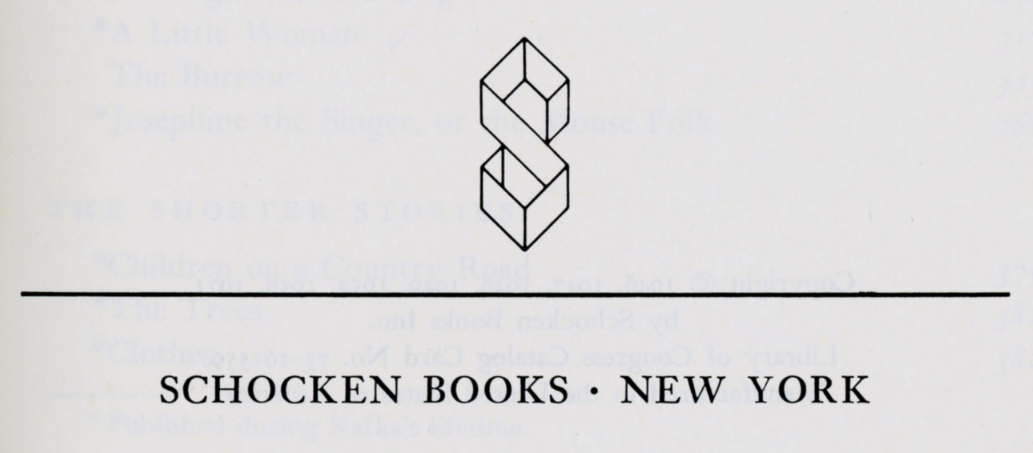Archive
Schocken Books
- Schocken Books
- Publishing House
Schocken Books was a publishing house established in 1945 in New York by the Russian émigré Salman Schocken (1898–1959). It specialised in books on Judaica and Hebrew topics.
Word Count: 26
342 Madison Avenue, Midtown Manhattan, New York City (1945–12.1955); 67 Park Avenue, Midtown Manhattan, New York City (12.1955–1973); 200 Madison Avenue, Midtown Manhattan, New York City (1973–1987).

Schocken Books logo (Private Archive Helene Roth). 
Letterhead of Schocken Books Inc., May 1955, Lotte Jacobi Archive, Correspondence (© 2020. University of New Hampshire). 
Letterhead of Schocken Books Inc., July 1955, Lotte Jacobi Archive, Correspondence (© 2020. University of New Hampshire). 
Letterhead of Schocken Books Inc., 1973, Lotte Jacobi Archive, Correspondence (© 2020. University of New Hampshire). 
First page of Polish Jews. A Pictorial Record by Roman Vishniac (Schocken Books, 1947). 
Robert Cromie. “Exceptional Photos Made by Roman Vishniac.” Chicago Tribune, 7 September 1947, p. 221. Abel, Richard, and Gordon Graham, editors. Immigrant Publishers. The Impact of Expatriate Publishers in Britain and American in the 20th Century. Transaction Publishers, 2009.
Cromie, Robert. “Exceptional Photos Made by Roman Vishniac.” Chicago Tribune, 7 September 1947, p. 221.
David, Anthony. The Patron. A Life of Salman Schocken, 1877–1959. Metropolitan Books, 2003.
Mahrer, Stefanie. Salman Schocken. Topographien eines Lebens (Jüdische Kulturgeschichte in der Moderne, vol. 24). Neofelis, 2021.
McNamara, Katherine. “A Conversation about Schocken Books. Part I with Altie Karper and the Editor of Archipelago.” Archipelago, vol. 5, no. 2, Summer 2001. Accessed 15 February 2021.
McNamara, Katherine. “A Conversation about Schocken Books. Part II with Susan Raltson and the Editor of Archipelago.” Archipelago, vol. 5, no. 3, Autumn 2001. Accessed 15 February 2021.
McNamara, Katherine. “A Conversation about Schocken Books. Part III with Arthur Samuelson and the Editor of Archipelago.” Archipelago, vol. 6, no. 1, Spring 2002. Accessed 15 February 2021.
Spalek, John M, et al., editors. Deutsche Exilliteratur seit 1933. Francke, 1976.
Stadelmayer, Peter. “Die Rolle der jüdischen Verleger in der Literatur Deutschlands.” (unpublished manuscript, Leo Baeck Institute, New York, 1969).
Word Count: 174
- 1945
- 1987
- New York
- Helene Roth. "Schocken Books." METROMOD Archive, 2021, https://archive.metromod.net/viewer.p/69/2948/object/5145-9978769, last modified: 28-01-2022.
-
Lotte JacobiPhotographerNew York
In October 1935 the German émigré photographer Lotte Jacobi, together with her sister Ruth Jacobi, opened a photo studio on 57th Street. The two sisters had to leave their parents' photo studio in Berlin in the 1930s and emigrated to New York.
Word Count: 41
Chinatown U.S.A.PhotobookNew YorkChinatown U.S.A. is a photobook published by the German émigré photographer Elizabeth Coleman in 1946 focusing on American-Chinese communities in New York and San Francisco.
Word Count: 26
5th AvenuePhotobookNew York5th Avenue was the first photobook by Fred Stein and was created in 1947 with the publishing house Pantheon Books.
Word Count: 19
J.J. Augustin Incorporated PublisherPublishing HouseNew YorkJ.J. Augustin was a German publishing house in Glückstadt with a long history, going back to 1632. In 1936 the American branch opened in New York with a large artistic and cultural focus.
Word Count: 33
Pantheon BooksPublishing HouseNew YorkPantheon Books was a publishing house founded in 1942 by the German émigré Kurt Wolff (1887–1963) and aimed at the exiled European community in New York.
Word Count: 24
Oceana PublicationsPublishing HouseNew YorkOceana Publications Inc was a publishing house specialising in law and civil rights founded by the British émigré Philip F. Cohen (1911–1998) in 1945.
Word Count: 22
Querido Inc.Publishing HouseNew YorkFritz H. Landshoff’s Querido publishing house was originally an offshoot of Emanuel Querido's Querido Uitgeverij Dutch publishing house in Amsterdam. Querido Verlag was created in 1933 to publish work by German political exiles.
Word Count: 33
Black Star AgencyPhoto AgencyNew YorkThe German émigrés Kurt S(z)afranski, Ern(e)st Mayer and Kurt Kornfeld founded Black Star in 1936. The photo agency established was a well-run networking institution in New York.
Word Count: 31
PIX Publishing Inc.Photo AgencyNew YorkPIX Publishing Inc. was a photo agency founded in New York in 1935 by photo agent Leon Daniel and Celia Kutschuk, together with German émigré photographers Alfred Eisenstaedt and George Karger.
Word Count: 30
New School for Social ResearchAcademy/Art SchoolPhoto SchoolUniversity / Higher Education Institute / Research InstituteNew YorkDuring the 1940s and 1950s emigrated graphic designers and photographers, along with artists and intellectuals, were given the opportunity to held lectures and workshops at the New School for Social Research.
Word Count: 31
Camera FeaturesPhoto AgencyNew YorkCamera Features was a photo agency founded by the photographer Werner Wolff and other colleagues of the photo agency PIX.
Word Count: 20
Rapho GuillumettePhoto AgencyNew YorkFounded in 1940 by the emigrant Charles Rado (1899–1970), Rapho Guillumette was a picture agency.
Word Count: 13
European Picture ServicePhoto AgencyNew YorkThe European Picture Service was a photo agency located in Midtown Manhattan founded, probably in 1930, by the émigré photographer Max Peter Haas (1901–1985).
Word Count: 22